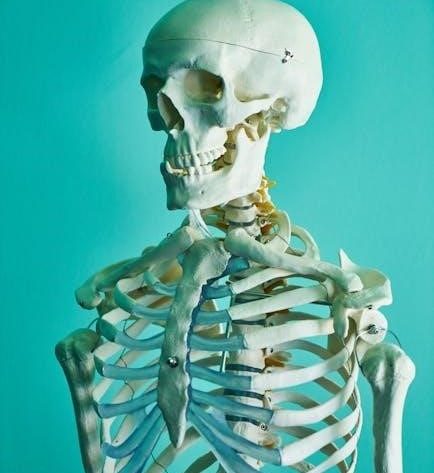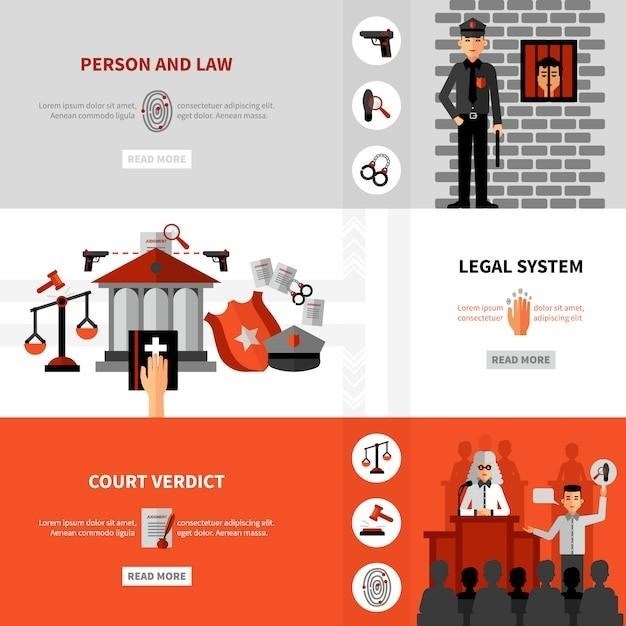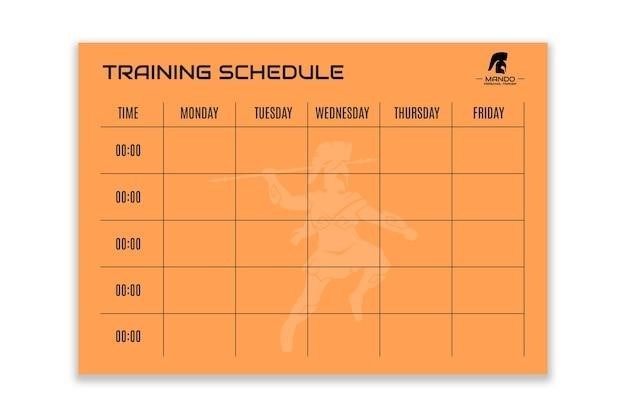This comprehensive guide simplifies complex concepts‚ making anatomy and physiology accessible to everyone. Perfect for students and curious learners‚ it covers body systems with clarity and ease‚ offering a color insert for visual learning.
Why Study Anatomy and Physiology?
Understanding anatomy and physiology is essential for grasping how the human body functions. It serves as the foundation for careers in medicine‚ nursing‚ and healthcare. By studying these subjects‚ you gain insights into bodily processes‚ such as movement‚ digestion‚ and circulation. This knowledge also fosters a deeper appreciation for health and wellness‚ enabling better decisions about personal care. For students and professionals alike‚ it builds a critical skill set for diagnosing and treating medical conditions‚ making it a cornerstone of scientific and practical learning.
Who Should Use This Guide?
This guide is ideal for students‚ healthcare professionals‚ and anyone curious about anatomy and physiology. It’s perfect for beginners‚ including high school or college students‚ seeking a clear introduction to the subject. Nurses‚ physical therapists‚ and medical professionals can use it as a refresher. Additionally‚ individuals interested in understanding how their body works will find it accessible and informative. The guide simplifies complex topics‚ making it a valuable resource for both learning and reference purposes.
What You’ll Learn in This Book
In this comprehensive guide‚ you’ll explore the fundamentals of anatomy and physiology‚ starting with the basic structure of the human body. You’ll discover how cells‚ tissues‚ and organs function together to form body systems. The book covers the skeletal‚ muscular‚ nervous‚ circulatory‚ respiratory‚ digestive‚ and urinary systems in detail. You’ll learn how these systems interact to maintain health and enable daily activities. Key concepts‚ such as muscle movement‚ neuron communication‚ and blood circulation‚ are explained clearly. This guide provides a solid foundation for understanding the human body’s intricate mechanisms.

The Basic Structure of the Human Body
The human body is organized into cells‚ tissues‚ organs‚ and systems‚ functioning together to maintain health and enable daily activities through coordinated physiological processes.
Cells: The Building Blocks of Life
Cells are the fundamental units of life‚ forming the basis of all biological structures and functions. They are microscopic‚ membrane-bound entities containing genetic material and essential organelles; Cells vary in structure and function‚ with prokaryotic cells lacking a nucleus and eukaryotic cells having a nucleus and specialized organelles. They perform vital functions like metabolism‚ reproduction‚ and responding to stimuli. Understanding cells is crucial for grasping how the human body operates at its most basic level‚ making them the foundation of anatomy and physiology studies.
Tissues and Organs
Tissues are groups of similar cells that work together to perform specific tasks. There are four primary types: epithelial‚ connective‚ muscle‚ and nervous tissue. Organs‚ such as the heart or liver‚ are structures composed of two or more types of tissues that function together to achieve a common purpose. Tissues and organs form the building blocks of body systems‚ enabling complex physiological processes. Understanding their organization and interdependence is essential for comprehending how the body maintains overall health and functionality.
Body Systems Overview
The human body is composed of 11 major systems that work together to maintain life and overall health. These systems include the skeletal‚ muscular‚ nervous‚ circulatory‚ respiratory‚ digestive‚ urinary‚ endocrine‚ integumentary‚ immune‚ and reproductive systems. Each system has unique functions‚ but they are deeply interconnected. For example‚ the circulatory system transports nutrients and oxygen‚ while the respiratory system provides the oxygen necessary for cellular energy production. Understanding how these systems interact and support each other is key to grasping the complexity of human anatomy and physiology.
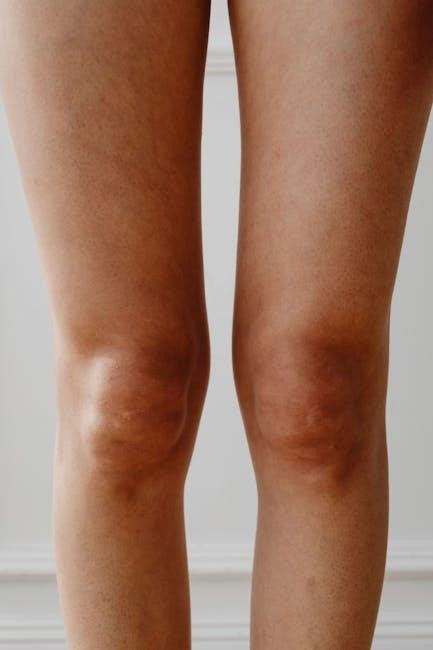
The Skeletal System
The skeletal system provides structural support‚ protects vital organs‚ and facilitates movement by serving as an attachment point for muscles. It also produces blood cells.
Bones and Their Functions
Bones are rigid‚ calcified structures that form the framework of the body. Adults have 206 bones‚ categorized into long‚ short‚ flat‚ irregular‚ and sesamoid bones. Their primary functions include providing structural support‚ protecting internal organs like the brain and heart‚ and facilitating movement by acting as levers for muscles. Bones also produce blood cells in the marrow and store minerals like calcium and phosphorus. Additionally‚ they play a role in hormone production‚ such as calcitriol for calcium absorption. Bones adapt to stress through remodeling‚ ensuring strength and flexibility throughout life.
Types of Joints and Their Movements
Joints‚ or articulations‚ are points where bones meet‚ enabling movement and flexibility. They are classified into three main types: synovial‚ cartilaginous‚ and fibrous. Synovial joints‚ like the knee and shoulder‚ are the most movable and contain synovial fluid for lubrication. Cartilaginous joints‚ such as those between vertebrae‚ allow limited movement. Fibrous joints‚ like skull sutures‚ have minimal movement. Joints facilitate activities by allowing bones to pivot‚ rotate‚ or glide‚ while also absorbing shock and reducing friction between bones during motion.
The Axial and Appendicular Skeleton
The human skeleton is divided into two main parts: the axial and appendicular systems. The axial skeleton includes the skull‚ spine‚ ribs‚ and sternum‚ forming the body’s central framework and protecting vital organs like the brain and heart. The appendicular skeleton comprises the upper and lower limbs‚ shoulders‚ pelvis‚ and hips‚ enabling movement and supporting the body’s weight. Together‚ these systems provide stability‚ facilitate movement‚ and protect internal structures‚ forming the structural foundation of the human body.
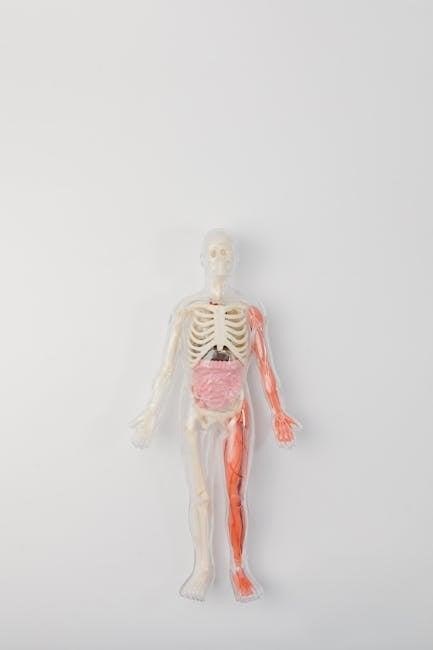
The Muscular System
The muscular system includes muscles‚ tendons‚ and ligaments‚ enabling movement‚ stability‚ and support. It works with the skeletal system to facilitate motion and maintain posture‚ while also protecting internal organs.
Types of Muscles: Skeletal‚ Smooth‚ and Cardiac
The muscular system comprises three types of muscles: skeletal‚ smooth‚ and cardiac. Skeletal muscles are attached to bones‚ enabling voluntary movements‚ such as walking or writing. Smooth muscles are found in internal organs like the digestive tract and function involuntarily‚ aiding processes like digestion. Cardiac muscle is exclusive to the heart‚ ensuring continuous‚ rhythmic contractions to pump blood. Each type has distinct structures and roles‚ working together to maintain bodily functions and overall health.
How Muscles Move the Body
Muscles move the body through contraction and relaxation; When skeletal muscles contract‚ they pull on tendons attached to bones‚ creating movement. This process is controlled by the nervous system‚ which signals muscles to act. Smooth muscles move substances like food through organs‚ while cardiac muscles pump blood. The sliding filament theory explains how muscle fibers generate force. Muscles work in pairs‚ with one contracting (agonist) and the other relaxing (antagonist). This coordinated effort enables precise movements‚ from walking to writing‚ and maintains posture and balance.
Muscle Disorders and Injuries
Muscle disorders and injuries can significantly impact movement and quality of life. Common issues include muscle strains‚ tendinitis‚ and tears. Conditions like fibromyalgia cause widespread pain‚ while muscular dystrophy leads to progressive muscle weakness. Overuse‚ trauma‚ or genetic factors often contribute to these problems. Symptoms may include pain‚ limited mobility‚ or muscle wasting. Treatment options vary‚ ranging from rest and physical therapy to surgery in severe cases. Proper care and rehabilitation are essential for recovery and maintaining muscle function.
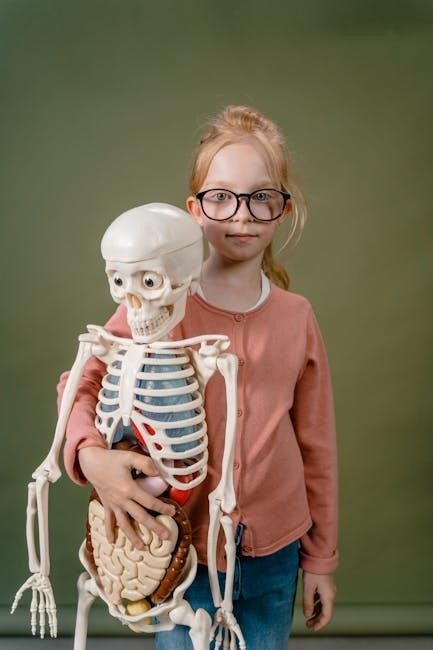
The Nervous System
The nervous system controls body functions‚ enabling communication through electrical and chemical signals. It includes the brain‚ spinal cord‚ and nerves‚ managing voluntary and involuntary actions‚ reflexes‚ and sensory input‚ ensuring coordination and regulation of bodily activities.
Structure of the Brain and Spinal Cord
The brain consists of the cerebrum‚ cerebellum‚ and brainstem. The cerebrum handles thoughts‚ emotions‚ and memory‚ while the cerebellum coordinates movements. The brainstem connects the brain to the spinal cord‚ regulating vital functions like breathing and heart rate. The spinal cord‚ part of the central nervous system‚ transmits nerve signals between the brain and the body. Protected by the spinal column‚ it plays a key role in reflexes and motor control‚ ensuring smooth communication and bodily responses.
How Neurons Communicate
Neurons communicate through electrical and chemical signals. Dendrites receive signals‚ which travel to the cell body. If the signal is strong enough‚ it reaches the axon‚ triggering an action potential. This electrical impulse travels down the axon to the axon terminals. Neurotransmitters are then released into the synaptic cleft‚ binding to receptors on adjacent neurons or cells. This process allows neurons to transmit information efficiently‚ enabling functions like movement‚ sensation‚ and thought. Proper communication is vital for the nervous system to operate effectively.
The Senses and Sensory Receptors
Sensory receptors detect stimuli from the environment‚ enabling us to perceive the world. These specialized structures convert stimuli into electrical signals transmitted to the nervous system. The five main senses—sight‚ sound‚ touch‚ taste‚ and smell—rely on specific receptors. For example‚ photoreceptors in the eyes detect light‚ while mechanoreceptors in the skin respond to touch. Additional receptors monitor pain‚ temperature‚ and balance. This complex system allows us to interpret and respond to external and internal stimuli‚ ensuring survival and interaction with our surroundings.

The Circulatory System
The circulatory system transports blood‚ supplying oxygen and nutrients while removing waste. It consists of the heart‚ blood vessels‚ and blood‚ maintaining overall health and function.
The Heart: Structure and Function
The heart is a muscular organ that pumps blood throughout the body. It has four chambers: the right and left atria‚ and the right and left ventricles. The septum separates the chambers‚ while valves ensure blood flows in one direction. The heart’s electrical system‚ including the sinoatrial node‚ regulates rhythmic contractions. During systole‚ ventricles pump blood‚ and during diastole‚ they relax to refill. This continuous cycle supplies oxygenated blood to tissues and deoxygenated blood to the lungs‚ maintaining life and overall bodily functions.
Arteries‚ Veins‚ and Blood Vessels
Arteries carry oxygen-rich blood away from the heart‚ while veins return oxygen-depleted blood to it. Arteries have thick‚ elastic walls to withstand high pressure‚ except for the pulmonary artery. Veins have one-way valves to prevent backflow and rely on muscle contractions for blood movement. Capillaries‚ tiny vessels between arterioles and venules‚ enable gas and nutrient exchange with tissues. Blood vessels form a closed system‚ maintaining circulation and overall health by regulating blood flow and pressure throughout the body.
Blood Composition and Its Role
Blood is a liquid tissue composed of plasma‚ red blood cells‚ white blood cells‚ and platelets. Plasma‚ the liquid portion‚ carries nutrients‚ hormones‚ and waste products. Red blood cells transport oxygen and carbon dioxide via hemoglobin. White blood cells fight infections‚ while platelets aid in clotting to prevent excessive bleeding. Blood circulates oxygen‚ regulates body temperature‚ and supports immune function‚ making it vital for overall health and survival.
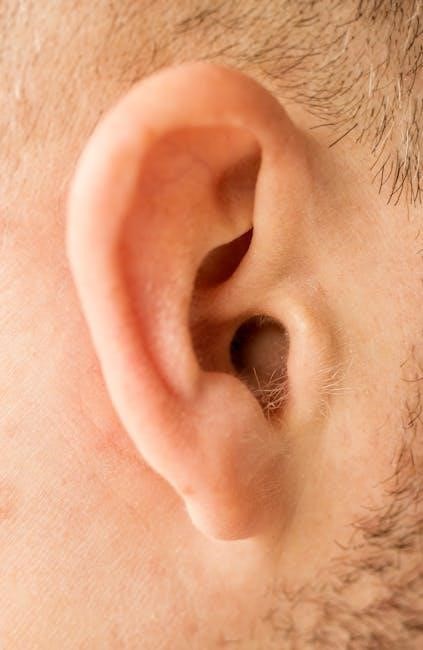
The Respiratory System
The respiratory system includes the nose‚ trachea‚ and lungs‚ enabling gas exchange. It brings oxygen into the body and removes carbon dioxide‚ supporting energy production and maintaining pH balance.
The Path of Air Through the Body
Air enters the body through the nostrils or mouth‚ passing through the nasal cavity and pharynx. It then moves into the larynx and trachea‚ which splits into bronchi and bronchioles. These airways branch into alveoli in the lungs‚ where gas exchange occurs. Oxygen diffuses into blood through alveolar walls‚ binding to hemoglobin in red blood cells‚ while carbon dioxide is expelled during exhalation. This process ensures efficient oxygen delivery and waste removal‚ maintaining proper cellular function and overall health.
Gas Exchange in the Lungs
Gas exchange occurs in the alveoli‚ tiny air sacs in the lungs‚ where oxygen from inhaled air diffuses into the bloodstream and carbon dioxide moves out. Oxygen crosses the alveolar wall and binds to hemoglobin in red blood cells‚ while carbon dioxide‚ a waste product‚ is expelled during exhalation. This process is essential for cellular respiration‚ enabling the body to produce energy. Efficient gas exchange relies on the large surface area of the alveoli and the thin membranes separating air and blood‚ ensuring proper oxygenation and waste removal.
Common Respiratory Disorders
Respiratory disorders‚ such as asthma and chronic obstructive pulmonary disease (COPD)‚ disrupt normal breathing and gas exchange. Asthma causes airway inflammation and constriction‚ leading to wheezing and shortness of breath. COPD‚ often linked to smoking‚ damages lung tissue and impairs airflow. Pneumonia‚ an infection in the alveoli‚ fills lungs with fluid‚ reducing oxygen absorption. Bronchitis inflames airways‚ producing excess mucus. These conditions can be acute or chronic‚ impacting quality of life. Early diagnosis and treatment are crucial to manage symptoms and prevent complications‚ ensuring proper respiratory function and overall health;
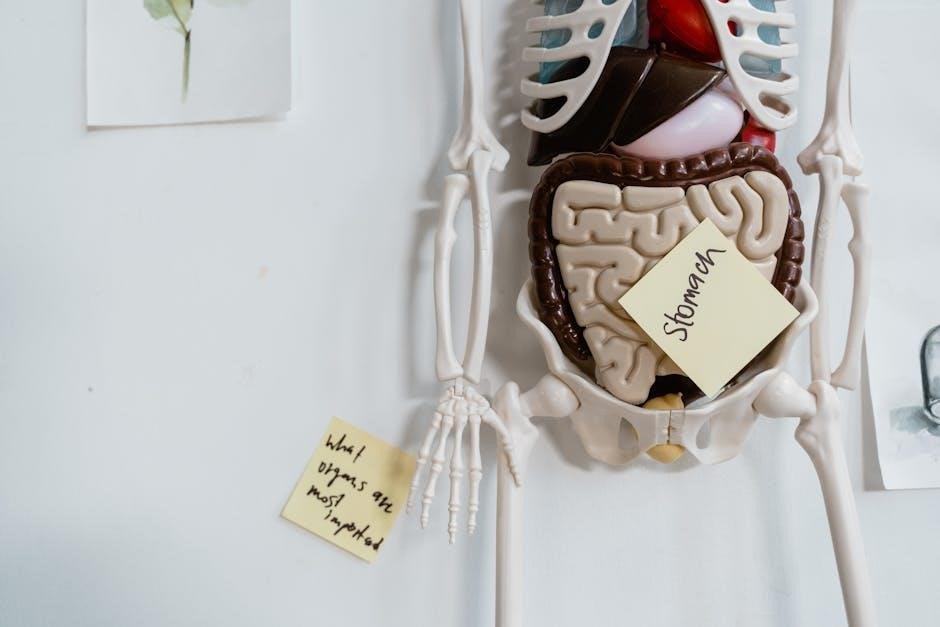
The Digestive System
The digestive system is a complex process involving organs that break down food into nutrients for energy‚ growth‚ and repair. It includes the mouth‚ esophagus‚ stomach‚ intestines‚ and accessory organs like the liver and pancreas‚ working together to digest and absorb nutrients efficiently while eliminating waste. Proper digestion is essential for maintaining overall health and bodily functions.
From Mouth to Stomach: The Digestive Process
Digestion begins in the mouth‚ where teeth chew food and saliva containing enzymes like amylase breaks down carbohydrates. The esophagus uses peristalsis to move the bolus to the stomach. In the stomach‚ strong muscular contractions mix food with gastric juices containing pepsin and hydrochloric acid‚ breaking proteins and killing bacteria. The pyloric sphincter regulates the release of chyme into the small intestine for further nutrient absorption. This step-by-step process ensures efficient digestion and prepares nutrients for absorption‚ maintaining energy and health.
The Role of the Small and Large Intestines
The small intestine absorbs nutrients through finger-like villi‚ increasing surface area for efficient absorption. Enzymes break down proteins‚ carbs‚ and fats into amino acids‚ glucose‚ and fatty acids‚ which enter the bloodstream. The large intestine absorbs water and electrolytes‚ forming solid waste. It houses gut flora‚ aiding in vitamin production (e.g.‚ vitamins K and B12) and fiber breakdown. Together‚ they ensure proper nutrient uptake and waste preparation‚ maintaining overall digestive health and bodily function. This dual process is vital for energy and nutrient utilization.
Key Digestive Enzymes and Hormones
Digestion relies on enzymes like amylase‚ lipase‚ and trypsin‚ which break down carbs‚ fats‚ and proteins. Gastrin stimulates stomach acid production‚ while secretin and cholecystokinin regulate bile and pancreatic enzyme release. Hormones like insulin and glucagon maintain blood sugar balance. These enzymes and hormones ensure efficient nutrient breakdown‚ absorption‚ and energy regulation‚ making them essential for overall digestive and metabolic health. Their coordinated action is crucial for proper bodily function and nutrient utilization.
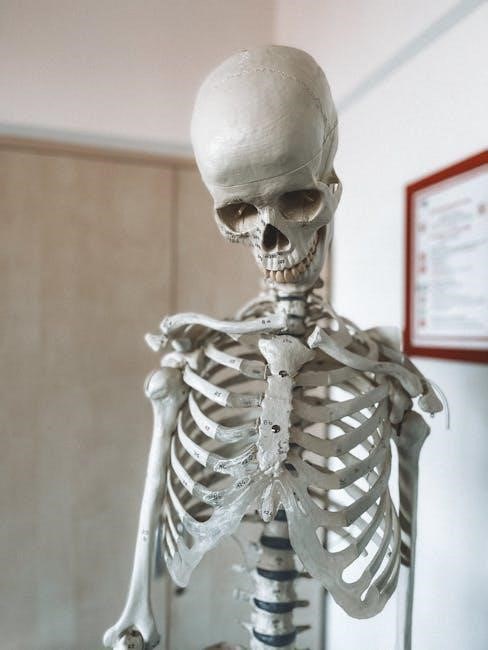
The Urinary System
The urinary system includes kidneys‚ ureters‚ bladder‚ and urethra‚ functioning to filter blood‚ regulate fluid balance‚ and eliminate waste through urine production and excretion.
Kidneys: Filters of the Blood
The kidneys‚ located in the lower back‚ are vital organs that filter blood to remove waste‚ excess fluids‚ and toxins. They process approximately 200 quarts of blood daily‚ producing urine. Each kidney contains millions of nephrons‚ the functional units responsible for filtration. The kidneys also regulate electrolyte balance‚ maintain acid-base equilibrium‚ and produce hormones like erythropoietin and renin. Their proper function is essential for overall health‚ preventing conditions like kidney failure and ensuring proper bodily waste elimination.
Urination and the Role of the Bladder
Urination is the process of eliminating urine from the body‚ regulated by the urinary system. The bladder‚ a hollow muscular organ‚ stores urine until it is full. When the bladder reaches its capacity‚ nerves signal the brain‚ triggering the urge to urinate. The detrusor muscle in the bladder wall contracts‚ and the urethral sphincter relaxes‚ allowing urine to exit. This process is essential for maintaining proper bodily functions and preventing infections or complications related to urine retention.
Common Urinary Tract Issues
Urinary tract infections (UTIs) are among the most common issues‚ often caused by bacteria entering the system. Symptoms include pain during urination‚ frequent urges‚ and cloudy urine. Kidney stones‚ hard mineral deposits‚ can block urine flow‚ causing severe pain. Incontinence‚ or loss of bladder control‚ may result from weakened muscles or nerve damage. These conditions highlight the importance of maintaining urinary health through proper hydration and hygiene to prevent complications and ensure optimal system function.
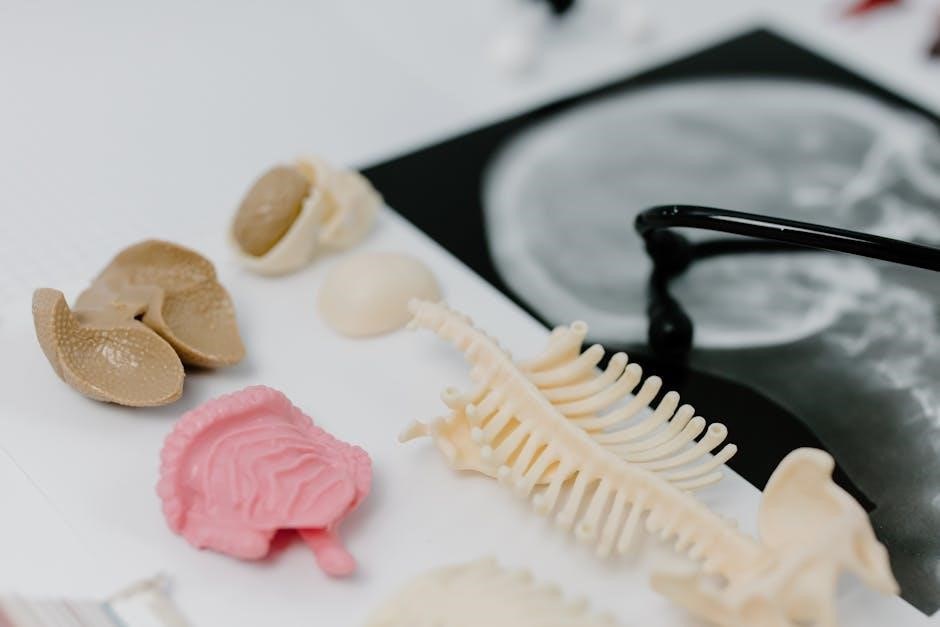
Additional Resources for Learning
Explore workbooks‚ online tools‚ and apps for interactive anatomy lessons; Utilize 3D software to visualize body structures and enhance your learning experience effectively.
The Anatomy and Physiology Workbook for Dummies offers hands-on exercises to reinforce learning. With practice questions‚ labeling diagrams‚ and interactive activities‚ it helps solidify concepts from the main guide. Designed for self-study‚ it includes quizzes‚ case studies‚ and lab-style exercises to apply knowledge practically. Whether you’re a student or a casual learner‚ this workbook provides a structured approach to mastering the human body’s intricacies. Use it alongside the textbook for a comprehensive understanding of anatomy and physiology.
Online Tools and Apps for Interactive Learning
Online tools and apps provide interactive ways to explore anatomy and physiology. Platforms like Kenhub and Visible Body offer 3D models and virtual labs. Apps such as Complete Anatomy allow users to dissect structures digitally. Websites like Labster simulate lab experiences‚ making learning hands-on. Quizzes and games on platforms like Kahoot make studying engaging. These resources complement traditional learning‚ offering visual and interactive approaches to understanding the human body. They are ideal for visual learners and those seeking a deeper grasp of complex physiological processes.
3D Anatomy Software for Visualizing the Body
3D anatomy software provides immersive tools to visualize the human body in detail. Programs like Zygote Body and BioDigital Human allow users to explore anatomy interactively. These platforms enable learners to rotate models‚ label structures‚ and study systems in depth. Many tools also offer dissection simulations and comparisons between healthy and diseased states. Accessible on desktops‚ tablets‚ and smartphones‚ these resources are invaluable for visual learners. They complement textbooks by making complex anatomical concepts engaging and easier to understand.
Key Takeaways from the Guide
This guide has covered the essential aspects of anatomy and physiology‚ emphasizing the interconnectedness of body systems. Key concepts include the structure and function of cells‚ tissues‚ and organs‚ as well as the roles of the skeletal‚ muscular‚ nervous‚ circulatory‚ respiratory‚ digestive‚ and urinary systems. Understanding these principles provides a solid foundation for appreciating how the body maintains homeostasis and responds to challenges. This knowledge is vital for anyone pursuing healthcare or simply seeking to understand the human body better. Further study and practical application are encouraged to deepen comprehension.
Encouragement for Further Study
Now that you’ve completed this guide‚ you’re well-equipped with a foundational understanding of anatomy and physiology. To deepen your knowledge‚ explore advanced texts‚ online courses‚ or hands-on workshops. Engage with interactive tools like 3D anatomy models or apps to visualize complex concepts. Join study groups or forums to discuss challenging topics. Remember‚ anatomy and physiology are dynamic fields‚ and continuous learning will enhance your appreciation of the human body. Keep curiosity alive and embrace lifelong learning to master these fascinating subjects.
